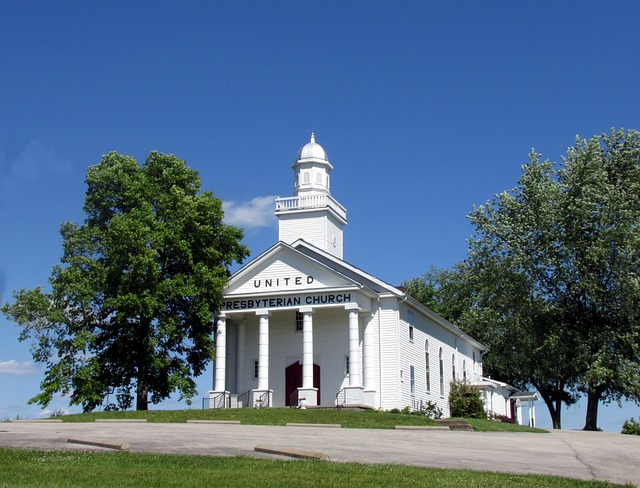Presbyterians typically use the cross as a symbol of their faith, rather than the crucifix.
Table of Contents
The Symbolism of the Cross in Presbyterian Worship
When it comes to the use of religious symbols in worship, different Christian denominations have their own traditions and practices. One question that often arises is whether Presbyterians use a cross or a crucifix in their worship services. The answer to this question lies in the symbolism of the cross in Presbyterian worship.
Presbyterians, like many other Protestant denominations, generally use a plain cross rather than a crucifix in their worship. The plain cross is a simple representation of the cross on which Jesus was crucified, without the figure of Jesus on it. This is in contrast to a crucifix, which includes a representation of Jesus on the cross.
The use of a plain cross in Presbyterian worship is rooted in the belief that Jesus’ death on the cross was a once-and-for-all sacrifice for the sins of humanity. Presbyterians emphasize the resurrection of Jesus and his victory over death, rather than focusing on his suffering on the cross. Therefore, the plain cross serves as a reminder of Jesus’ sacrifice and the hope of eternal life that his resurrection brings.
In Presbyterian worship, the plain cross is often displayed prominently in the sanctuary. It may be placed on or near the communion table, symbolizing the connection between Jesus’ sacrifice on the cross and the sacrament of the Lord’s Supper. The cross serves as a visual reminder of the central message of the Christian faith – the love and grace of God demonstrated through Jesus’ death and resurrection.
While the plain cross is the primary symbol used in Presbyterian worship, it is not the only symbol that holds significance. Presbyterian churches may also display other symbols, such as the Bible, the dove representing the Holy Spirit, or the fish symbolizing Jesus’ disciples. These symbols serve as reminders of different aspects of the Christian faith and help to create a worshipful atmosphere.
The use of symbols in worship is not meant to replace or overshadow the importance of the Word of God. Rather, symbols are used to enhance the worship experience and engage the senses in a way that complements the preaching and teaching of the Bible. Symbols can help to convey abstract concepts and make them more tangible and relatable to worshippers.
In conclusion, Presbyterians use a plain cross rather than a crucifix in their worship services. The plain cross symbolizes Jesus’ sacrifice on the cross and his victory over death through his resurrection. It serves as a visual reminder of the central message of the Christian faith and is often displayed prominently in the sanctuary. While the plain cross is the primary symbol used, other symbols may also be present to enhance the worship experience. Symbols are not meant to replace the Word of God but rather to complement it and engage the senses in worship.
Understanding the Presbyterian Perspective on the Use of Crosses

Do Presbyterians use cross or crucifix? This is a common question that many people have when it comes to understanding the Presbyterian perspective on the use of religious symbols. In order to fully grasp their viewpoint, it is important to delve into the history and beliefs of this denomination.
Presbyterians, like many other Protestant denominations, have a different approach to religious symbols compared to Catholicism or Eastern Orthodoxy. While these traditions often incorporate the use of crucifixes, which depict Jesus on the cross, Presbyterians tend to focus more on the empty cross as a symbol of the resurrection.
The empty cross holds great significance for Presbyterians as it represents the central message of their faith – the resurrection of Jesus Christ. It serves as a reminder of the victory over death and the hope of eternal life that is found in the Christian belief. By emphasizing the empty cross, Presbyterians aim to shift the focus from the suffering and death of Jesus to the triumph of his resurrection.
This emphasis on the empty cross is rooted in the Reformed tradition, which is the theological foundation of Presbyterianism. The Reformed tradition places a strong emphasis on the sovereignty of God and the grace of Jesus Christ. For Presbyterians, the empty cross symbolizes the power and grace of God, rather than the suffering and sacrifice of Jesus.
It is important to note that this does not mean that Presbyterians reject or dismiss the crucifix entirely. While the empty cross is the primary symbol used in Presbyterian worship and iconography, some Presbyterian churches may still have crucifixes displayed, especially in more traditional or diverse congregations. However, the empty cross remains the predominant symbol in Presbyterian worship spaces.
The use of religious symbols, including the cross, varies among individual Presbyterian churches and congregations. Some may choose to display crosses or crucifixes as a way to honor and remember the sacrifice of Jesus, while others may prefer a more minimalist approach. Ultimately, the decision to use crosses or crucifixes is left to the discretion of each individual congregation and its leadership.
In addition to the empty cross, Presbyterians also place a strong emphasis on the Word of God, particularly the Bible. The preaching and teaching of Scripture hold a central role in Presbyterian worship and theology. This focus on the Word of God further reinforces the Presbyterian perspective on the use of religious symbols, as they believe that the message of the Gospel is best conveyed through the proclamation of Scripture rather than through visual representations.
In conclusion, Presbyterians primarily use the empty cross as a symbol of the resurrection and the hope of eternal life. This emphasis on the empty cross is rooted in the Reformed tradition and reflects the Presbyterian belief in the power and grace of God. While some Presbyterian churches may still display crucifixes, the empty cross remains the predominant symbol in Presbyterian worship spaces. Ultimately, the use of crosses or crucifixes is a matter of individual congregation preference.
Historical Origins of Cross Usage in Presbyterianism
Do Presbyterians use a cross or a crucifix? This is a question that has puzzled many people over the years. To understand the answer, we need to delve into the historical origins of cross usage in Presbyterianism.
Presbyterianism, as a branch of Protestant Christianity, emerged in the 16th century during the Protestant Reformation. The movement was led by John Calvin, a French theologian, who sought to reform the Catholic Church. One of the key principles of Calvinism was the rejection of religious imagery, including the use of crucifixes.
Calvin believed that the use of crucifixes and other religious symbols was a form of idolatry, as it diverted attention away from the true focus of worship, which should be on God alone. Instead, Calvin advocated for a simpler form of worship, devoid of any visual distractions. This rejection of religious imagery extended to the use of crosses as well.
However, it is important to note that not all Presbyterians followed Calvin’s teachings to the letter. Over time, different Presbyterian denominations developed their own practices and interpretations of Calvinism. Some Presbyterian churches, particularly those influenced by the Scottish tradition, continued to reject the use of crosses in their worship.
In Scotland, the Presbyterian Church of Scotland, also known as the Church of Scotland, played a significant role in shaping Presbyterianism. The Church of Scotland, which traces its roots back to the Scottish Reformation in the 16th century, has traditionally adhered to a strict interpretation of Calvinism. As a result, the use of crosses in their worship has been minimal.
However, it is worth noting that not all Presbyterian churches around the world follow the same practices. In some Presbyterian denominations, particularly those in North America, the use of crosses is more common. This is due to a variety of factors, including the influence of other Protestant traditions and the desire to create a more inclusive and diverse worship experience.
In these Presbyterian churches, the cross is often seen as a symbol of Christ’s sacrifice and a reminder of the central message of Christianity. While they may not use crucifixes, which depict Jesus on the cross, the cross itself is still considered a powerful symbol of faith.
In conclusion, the use of crosses in Presbyterian worship varies depending on the specific denomination and cultural context. While some Presbyterian churches, particularly those influenced by the Scottish tradition, have historically rejected the use of crosses, others have embraced them as a symbol of Christ’s sacrifice. Ultimately, the decision to use a cross or a crucifix is a matter of personal and denominational preference.
Exploring the Role of the Crucifix in Presbyterian Theology
Do Presbyterians use a cross or a crucifix? This is a question that often comes up when discussing Presbyterian theology. While both symbols hold significant meaning for Christians, there are some differences in how they are used and interpreted within the Presbyterian tradition.
In Presbyterian theology, the focus is primarily on the cross rather than the crucifix. The cross is a powerful symbol of Christ’s sacrifice and redemption, representing the central message of the Christian faith. It serves as a reminder of Jesus’ death and resurrection, and the hope and salvation that it brings.
Unlike the crucifix, which depicts Jesus on the cross, the cross used by Presbyterians is typically empty. This is because Presbyterians emphasize the resurrection of Christ and his victory over death. The empty cross serves as a symbol of hope and new life, reminding believers of the transformative power of Christ’s sacrifice.
The use of the empty cross in Presbyterian worship and symbolism is not meant to diminish the importance of Jesus’ suffering on the cross. Rather, it is a way of emphasizing the triumph of the resurrection and the hope that it brings to believers. It is a reminder that Jesus’ death was not the end, but rather the beginning of a new and eternal life.
In Presbyterian churches, you are more likely to find an empty cross displayed prominently rather than a crucifix. This is not to say that crucifixes are completely absent from Presbyterian worship spaces, but they are less common. The focus is on the cross as a symbol of redemption and hope, rather than on the suffering of Jesus depicted in the crucifix.
The emphasis on the empty cross in Presbyterian theology also reflects a broader theological perspective. Presbyterians believe in the sovereignty of God and the power of grace. They emphasize the importance of faith in Christ’s sacrifice and the transformative work of the Holy Spirit in the lives of believers.
For Presbyterians, the empty cross serves as a reminder of the central message of the Gospel – that through Christ’s death and resurrection, believers are reconciled to God and offered the gift of eternal life. It is a symbol of hope and a call to live in light of the resurrection, embracing the new life that Christ offers.
While the use of the empty cross is more common in Presbyterian worship, it is important to note that there is no strict rule or requirement regarding the use of symbols. Different Presbyterian churches may have varying practices and preferences when it comes to the use of crosses and crucifixes.
Ultimately, the choice between a cross and a crucifix is a matter of personal and congregational preference within the Presbyterian tradition. Both symbols hold deep meaning and significance for Christians, and both can serve as powerful reminders of Christ’s sacrifice and the hope that it brings.
In conclusion, while Presbyterians primarily use the empty cross as a symbol of Christ’s sacrifice and victory over death, the use of crucifixes is not completely absent from Presbyterian worship spaces. The focus is on the resurrection and the hope that it brings, emphasizing the transformative power of Christ’s sacrifice. Ultimately, the choice between a cross and a crucifix is a matter of personal and congregational preference within the Presbyterian tradition.
Conclusion
Presbyterians typically use the cross rather than the crucifix.


